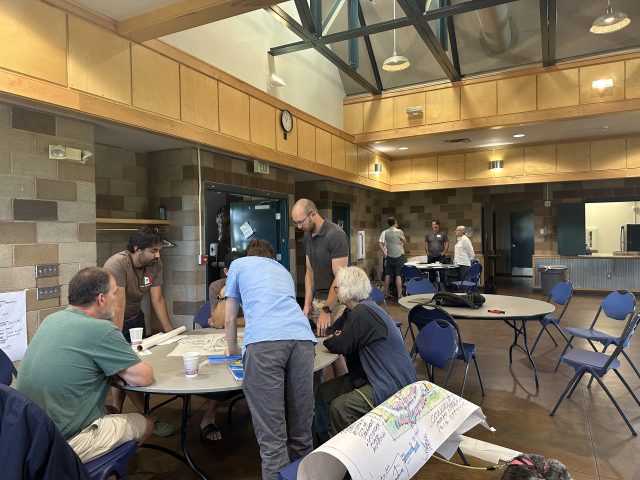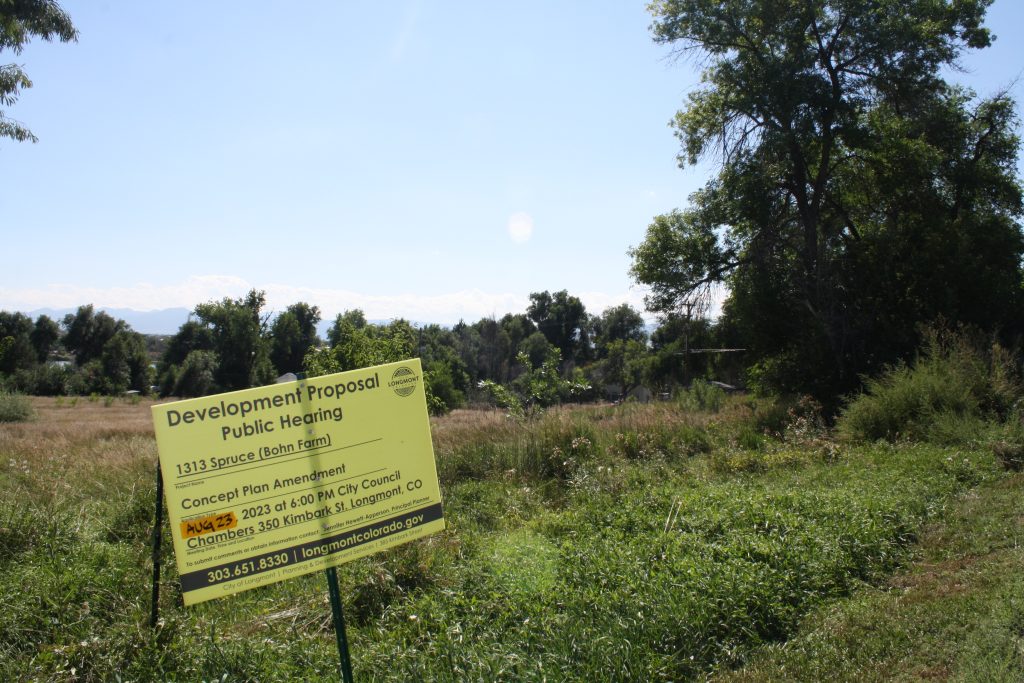
It’s a sunny Saturday morning, and some 20 people have gathered at the Izaak Walton Clubhouse in Longmont to discuss the hotly debated development of a piece of property in the historic Bohn Farm neighborhood.
But the scene plays out more like a group project at the library than an angry lot of citizens at a town hall.
Neighbors, developers and industry professionals are broken into small groups and huddle around tables, drawing up and modifying plans for a nearly 6-acre plot at 1313 Spruce Ave. Each group then presents their proposal to the whole collective. Participants are told to make a list of the ideas they like and that the rest of the suggestions will fall away.
After the presentations are complete, the meeting’s facilitator, Brian Dunbar, tells participants to write the top five recommendations they heard on Post-it notes, which are then sorted into categories to find the areas of consensus.
In one camp are those who want a high-density development with more than 70 units of housing, as the region is in dire need of affordable stock. In the other camp are those who want no more than 46 units, citing concerns about parking, density and preservation of neighborhood character.
“There’s people here that really don’t like the project … and yet now they’re all working together to make it happen,” Dunbar says. “They’re sitting right along with the architect. They’re getting their ideas integrated in, but there’s compromise happening. So it’s this teamwork. All of a sudden, you feel like you’re working on the same thing instead of being opposed. That’s why this process is so wonderful.”
The presentations are the culmination of three charrettes, a collaborative meeting process designed to help opposing parties reach a consensus. The neighbors have spent Friday evening and much of the day Saturday working through conceptual plans for the development, with some participants saying they clocked more than 20 hours of work during three charrettes.
Although the Saturday meeting becomes charged at times, several neighbors say they left feeling encouraged. Some say they feel the process was disingenuous, while others say lack of participation from members of the group favoring lower density hindered the process.
“Whenever you talk constructively, it’s never a loss,” says Ted O’Neill, a participant who favors lower density, adding that he was encouraged by participation from the lead developer, Mark Young, and his team. “Showing good faith is really key in this because there’s so much suspicion and criticism. It’s so much easier to criticize than to be positive.”
After a nearly six-hour meeting on Aug. 23, Longmont’s Planning and Zoning Commission voted to recommend the approval of the developer’s concept plan to City Council. The concept plan allows for up to 70 units — the same number as the originally submitted concept — with an added transition zone of two-story single family and duplex units along the northern and eastern bounds of the property, which developers say will likely limit the total number of units.
Shakeel Dalal, a Bohn Farm resident who favors higher-density development, calls the charrettes “temperature-lowering.” While he ultimately wanted more units, Dalal said during the public comment of the Planning and Zoning meeting that he believes “reaching consensus requires compromise.”
‘Checking our egos at the door’
Dunbar, executive director at Colorado State University’s Institute for the Built Environment, has facilitated charrettes for more than 30 years and says he’s had only a few projects “as contentious” as the development at Bohn Farm.
Boulder County is no stranger to development debates; Bohn Farm is just the latest deeply contentious iteration. In a city where owner-occupied housing averages just under half a million dollars with a population that’s grown by more than 12,000 since 2010, according to census data, it’s hardly surprising that development is a hot-button issue.

Jennifer Hewett-Apperson, Longmont’s principal city planner, says she’s not aware of other projects in the city that have used a community-centered charrette process. She says it’s “prompted a lot of discussion and some good ideas” and could be a good tool for future large-scale projects.
Drew Sorrells, a Bohn Farm neighbor and interior designer, organized the charrettes with her husband. The couple were initially part of the Bohn Farm Neighborhood Group fighting for lower density, and began acting as liaisons between the community group, the developers and industry professionals.
Sorrells says they later decided to work independently of the neighborhood group after learning “things that the neighborhood was fighting for, like lower density, we learned from those professionals it’s not gonna fly because we need more housing, and the City wants more housing.”
“[We] basically decided that the only way we’re going to bring unity in this community was to bring all of us together,” she says. “There’s a sense we’re all kind of checking our egos at the door, we’re going to come in and see if all of us can compromise a little bit.”
The top categories of consensus that emerge from the Post-it note exercise in the charrette include walkability, having the park on the west side, green space and affordability. There’s also consensus on offering live-work spaces within the neighborhood.
“Here is a non-evasive [exercise] trying to see what the opposites have in common … instead of personalizing the process, we’re trying to make it impersonal and collective,” Sorrells says.
‘Something we haven’t had before’
The conceptual site plan favored by charrette participants, which was later presented at the Planning and Zoning meeting, has a park located on the west side of the development to serve the whole neighborhood and a woonerf design that mixes street use, effectively forcing cars to go 5 mph. It creates pockets of play areas for kids and three walking paths throughout the development. As per City regulations, 12% of the development’s approximately 60 units would be affordable. Those units would be mixed throughout the property’s simple pitched-roof architecture — something many charrettes participants agreed fit the character of the neighborhood.
“We did actually come up with a concept … that we can agree on,” O’Neill says. “And that’s something we haven’t had before.”


Young, the Boulder-based developer, said in the Planning and Zoning meeting he liked the group’s plan better than his initial plan. While he’s been involved in charrettes for other developments before, this is his first that’s involved community members.
“I’ve heard from a lot of people in the community and design professionals that there are ways to make the site more inviting and create a more cohesive atmosphere in the community,” Young says. “We’re going to implement those. We’re going to do the best we can to make sure that as we develop the site, we develop it with those ideas in mind.”
Still, some neighbors are unhappy with the charrettes’ outcome and the concept plan.
“I wish I could report to you that this effort was worthwhile. It was not,” said Cheryl Carter-Pierce, a Bohn Farm resident in favor of lower density, during the Planning and Zoning meeting. “We are left with a bad feeling and a loss of trust.”
Carter-Pierce said she was disappointed by the lack of certain stipulations and that the concept plan was submitted before the end of the final charrette.
For Young, the biggest hurdle ahead will be whether the conceptual site plan from the charrette is feasible from an engineering and code perspective. He cited community members’ inexperience and misunderstandings about code and processes as challenges with the charrettes, but says it ultimately allows residents to engage in a process they wouldn’t typically be involved in, making the project “better than it was when we started.”
Geri Boone, a Planning and Zoning commissioner who voted to approve the concept plan, said in the Aug. 23 meeting she was disappointed in members of the neighborhood group who were “not as open.” While the Bohn Farm Neighborhood Group has more than 200 members, only a few attended the charrettes — making it challenging to reach true consensus.
Boone said she thought the charrettes showed “good faith” by the developer.
“The presentation you made tonight is so much more compatible than the prior presentation,” she said. “You can’t have affordability without density. You just can’t.”
The project still has several rounds of approval before construction can begin — and maybe more charrettes. First, it will move to City Council with a reading of the ordinance on Sept. 26, then a public hearing and a vote by Council on Oct. 10. If approved, the plan will go through the preliminary plat process, which requires Planning and Zoning Commission approval, followed by site, public plat and public improvement plans, which require staff review. Young says he hopes construction can begin by early summer 2024, and he’s confident he can change the minds of neighbors who are still wary of the development.
“Time heals all wounds,” he says. “Keep an eye on the project. It’ll surprise them. And when it’s done a couple of years from now, everybody will be happy with it.
Clarification: Drew Sorrells and her husband live just outside the official Bohn Farm Neighborhood on the north side of 3rd on Grant Street and previously lived in the neighborhood.














